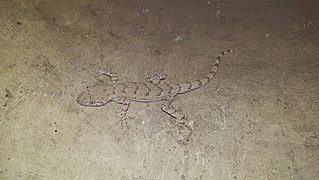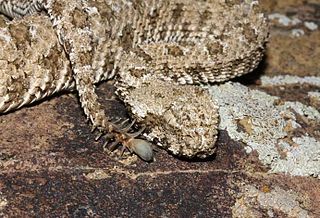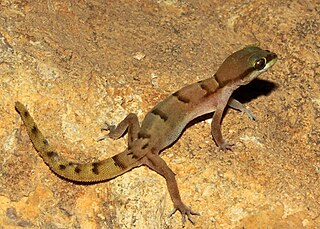
Gekkonidae is the largest family of geckos, containing over 950 described species in 64 genera. Members of the Gekkonidae comprise many of the most widespread gecko species, including house geckos (Hemidactylus), tokay geckos (Gekko), day geckos (Phelsuma), mourning geckos (Lepidodactylus) and dtellas (Gehyra). Gekkonid geckos occur globally and are particularly species-rich in tropical areas.

Agamura is a genus of geckos.

Asaccus is a genus of geckos, commonly known as Southwest Asian leaf-toed geckos, in the family Phyllodactylidae.

Teratoscincus is a genus of geckos commonly referred to as wonder geckos or frog-eyed geckos; it is the only genus within the subfamily Teratoscincinae of the family Sphaerodactylidae. Species in the genus Teratoscincus are found from the Arabian Peninsula in Qatar, the United Arab Emirates, and Oman, west across southern Asia in Iran, Afghanistan, and Pakistan, north to Russia, Kazakhstan, Turkmenistan, Uzbekistan, and Tajikistan to Mongolia and China. The genus consists of nine species.

Mediodactylus is a genus of Gekkonidae (gecko) family. It contains the following species:

Tropiocolotes is a genus of geckos, lizards in the family Gekkonidae. The genus is native to North Africa and the Middle East. Species in the genus Tropiocolotes grow to a total length of about 2 in (5.1 cm). They are commonly known as dwarf geckos, pygmy geckos, or sand geckos. They have an elongated body and the head is oval and of equal or lesser width than the body.

Eremias is a genus of lizards in the family Lacertidae, the wall lizards. They are native to Asia and southeastern Europe, where they live in desert and steppe regions.

Pseudocerastes is a genus of vipers endemic to the Middle East and Asia. It was originally created as a monotypic genus in 1896 by Boulenger for the species Pseudocerastes persicus, but three species are now recognised: the spider-tailed horned viper ; Persian horned viper and Field's horned viper. Like all other vipers, the members of this genus are venomous.

Eirenis is a genus of Old World snakes in the family Colubridae.

The spider-tailed horned viper is a species of viper, a venomous snake, in the family Viperidae and genus Pseudocerastes. The genus is commonly known as "false-horned vipers".
The Kurdistan leaf-toed gecko is a species of lizard belonging to the gecko family Phyllodactylidae. A. kurdistanensis is native to the Kurdistan province in western Iran and was described in 2006.
Acanthodactylus nilsoni, commonly called Nilson's spiny-toed lizard, is a species of lizard in the family Lacertidae. The species is endemic to Iran.
Microgecko helenae, also known commonly as the banded dwarf gecko, Helen's banded dwarf gecko, Helen's tiny gecko, the Khuristan dwarf gecko, or the Khuzestan dwarf gecko, is a species of lizard in the family Gekkonidae. The species is endemic to western Iran.

Latifi's dwarf gecko, also known commonly as the Zagros tiny gecko, is a species of lizard in the family Gekkonidae. The species is endemic to Iran.

Asaccus nasrullahi, Nasrullah's leaf-toed gecko, is a species of gecko in the family Phyllodactylidae. The species is endemic to Iran. The specific name nasrullahi was chosen in honor of Iranian herpetologist Nasrullah Rastegar-Pouyani, "in recognition of his contribution to the knowledge of the herpetology of Iran, including the genus Asaccus".
Iranolacerta is a genus of wall lizards of the family Lacertidae.
Iranolacerta brandtii, also known commonly as Brandt's Persian lizard, is a species of lizard in the family Lacertidae. The species is native to eastern Europe and western Asia. There are two recognized subspecies.

Microgecko persicus, known as the Persia sand gecko or Persian dwarf gecko, is a species of lizard in the family Gekkonidae. The species is endemic to Iran, Iraq and Pakistan. As of January 2019 its conservation status has not been assessed on the IUCN Red List.
The Laki dwarf gecko is a species of lizard in the family Gekkonidae. It is endemic to Iran.
Chernov's snake skink is a species of skink, a lizard in the family Scincidae. The species is native to Western Asia and Central Asia.












